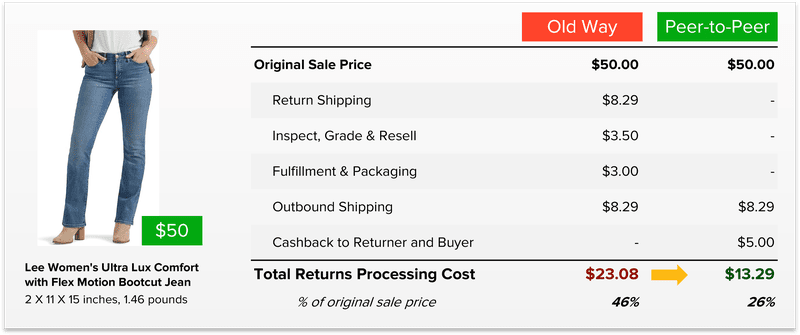Top 12 Shipping Strategies For Making Free Shipping Profitable

Last updated on March 10, 2025
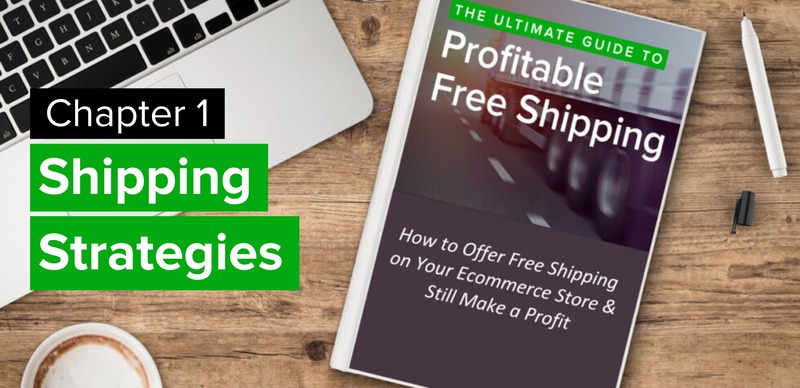
In this article
 31 minutes
31 minutes
- Structured Negotiation with Multiple Carriers
- Convince Suppliers to Use Your Shipping Account
- Use Trade or Group Association Discounts
- Use Shipping Label Software
- Maximize Ground Shipping Services
- Try Amazon Shipping
- Take Advantage of ‘Hybrid' Shipping Services
- Consider a Regional Carrier or Regional Rates
- Avoiding Residential Address Surcharges
- Use Zone Skipping for High Volume Zones
- Use International Freight Forwarders to Fulfill International Orders
- Selling Internationally through Full-Service Cross-Border Solutions
- Summary
- Frequently Asked Questions
For ecommerce sellers, shipping is more than just getting a package from point A to point B — it’s the invisible backbone, quietly shaping customer satisfaction, operational costs, and, ultimately, your bottom line. Yet, as carriers raise their rates and consumer expectations for fast, free shipping continue to rise, businesses are left with a difficult choice: absorb the costs, pass them on to customers, or find a smarter way to optimize logistics to avoid sacrificing profit.
The good news? You don’t have to choose between customer satisfaction and profitability. With the right shipping strategies — whether it’s negotiating better carrier rates, using regional shipping options, or leveraging technology to streamline fulfillment — you can reduce costs while maintaining service quality. This guide explores key tactics to help businesses of all sizes take control of their shipping costs and turn logistics into a strategic advantage.
1. Structured Negotiation with Multiple Carriers
Shipping costs are easily the biggest component of your order fulfillment prices, worse if you happen to sell big bulky items. But the problem is, every year the carriers increase their rates while you have to keep prices low to stay competitive. Giants like Amazon can afford to subsidize their deliveries, but how are you to offer free shipping as a small business?
Well, a lot.
With Amazon’s transportation business, Amazon Shipping, enabling the company to reduce its reliance on USPS, UPS, and FedEx, these national carriers are doing all they can to retain their customers. For these carriers, every bit of business is important to retain shareholder value. This presents you with the perfect opportunity to pull up your socks and put on your negotiation cap.
The key is shopping around and negotiating with your carrier Account Manager (if you have one). Chances are you’ll get a better deal if you can convince carriers that you are a reliable source of repeat business. First, you’ll have to gather what your business’ shipping needs are and then you formulate a formal Request for Proposal (RFP). This RFP document will help carriers assess your needs and tailor a deal for you. It’s easier to distribute this document across multiple carriers rather than setting up one-on-one discussions with everyone too early in the negotiation. For more details, Logiwa does an excellent job of explaining how to go about it.
There’s a merit to being well-prepared for your negotiation. Be sure to really understand what sort of shipping profile your business has, ranging from:
- Breakdown of your historical shipping speeds (Ground, Express, Consolidation)
- Shipment weights and dimensional weights
- Percentage of residential vs. commercial deliveries, including weekend deliveries
- How often errors and corrections like address changes and incorrect weights occur

Having a clear sense of what your business really needs helps you avoid paying for features you don’t really need in your deal with the carrier and makes sure that you do negotiate for the items that you use the most. Pulse Commerce also has a great in-depth article on how you can negotiate better rates using shipping data and analytics.
2. Convince Suppliers to Use Your Shipping Account
You might be leaving money on the table if you use your shipping account for only outbound shipments from your warehouse(s). Most ecommerce Sellers get inbound inventory shipments from their suppliers. If you’re one of those merchants, it would be a good idea to convince your suppliers to send them using your shipping account, meaning the carrier will bill you directly for the inbound shipment. This translates to more shipping volume on your account, and if we learned anything from the first tip, the more volume you have the more bargaining power you’ll have as well. In addition, you might already hit a higher volume discount even before further negotiations.
There are third-party contract negotiation/optimization solutions such as TransImpact, ShipSigma, and ShipRx, (among many others), that will analyze your shipping history for you, identify the most commonly used services, sizes, weights, and accessorial fees, and then help you negotiate your best agreement. With over 600 negotiable terms in a UPS contract, for example, outsourcing the work could make sense.
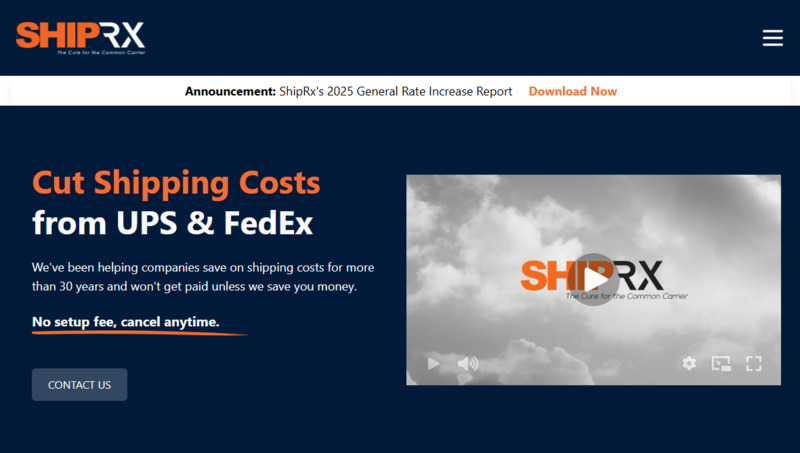
Lastly, make sure to request that any outsourced fulfillment partners also use your negotiated accounts. Modern ecommerce order fulfillment providers such as Cahoot have a Bring Your Own Carriers option that allows you to keep your volume on your accounts while outsourcing the fulfillment logistics to increase efficiency and lower cost.
A simple solution would be to set up a process through which suppliers can provide you with all the shipment details and you can provide them with the shipping labels. You can email those labels directly to them, and they can be printed, and packages can be handed over to the carrier.
3. Use Trade or Group Association Discounts
Trade organizations such as the American Bar Association or the Outdoor Industry Association are not just good for their annual conferences and shows, but they also offer a lot of advantages to their members. One of them is working together to help businesses reach scale when buying goods and services.

image courtesy: UPS
Shipping carriers often have relationships with many professional associations and offer member discounts. Depending on the size of the organization, you could be eligible for discounted rates of up to 50 percent with UPS and FedEx.
While UPS does not advertise the associations they offer discounts to, don’t hold back from asking your Account Manager or your association, whether you qualify. By aggregating your volume with that of your industry peers, you may just find that you’ve been missing out on a lucrative opportunity.
4. Use Shipping Label Software
There are two types of shipping label software we’re talking about in this tip: multi-carrier channel-integrated shipping label software such as Cahoot or ShipStation, and specific carrier websites that support online shipping label generation, such as USPS.
Shipping label software is an easy opportunity for Sellers who are new to ecommerce and/or haven’t reached the volume to qualify for negotiated rates or discounted 3PL services yet to get access to discounted rates. Cahoot, ShipStation and many others aggregate their shipping volume to negotiate big discounts with several carriers each and pass the savings onto their customers. Alternatively, you can print your shipping labels at usps.com instead of at the post office counter and enjoy the same reduced rates (commercial program) available to larger shippers. Discounted USPS shipping labels can also be purchased through authorized USPS postage services like Endicia which claims savings of up to 40%, whereas Stamps.com can save you up to 30% on Priority Mail services. Online shipping with USPS also saves you from carrying all your packages to the post office with its free parcel pickup service.
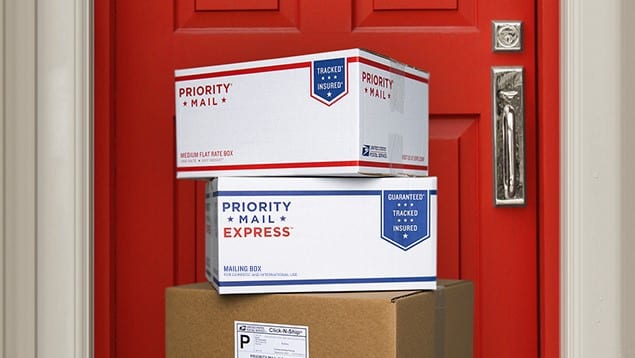
image courtesy: UPS
Using USPS is ideal only if you are shipping packages weighing less than two pounds. For heavier packages, it’s less expensive to go with the private carriers (FedEx and UPS). For private carriers, it’s best to open an account online rather than shipping them through the physical stores (e.g. The UPS Store and FedEx Office). These carriers reward the Do-it-yourself mentality! If you pay & print labels online and drop them off at the carrier store, you can save up to 50% compared to doing all of this directly at the carrier’s store.
5. Maximize Ground Shipping Services
Free shipping is a great motivator for shoppers even if it means getting the delivery a little later in some cases. According to a study published by McKinsey & Company in 2025, 95% of online shoppers prefer free standard delivery over paid expedited delivery, and 8 out of 10 shoppers are willing to wait even longer for a free shipment. Therefore, using the cheaper ground shipping option may be your best bet.
Similar to tip #3, which aims to add enough margin to the shopping cart subtotal to make free shipping viable, an alternative is to provide free shipping but at a slower speed. Consider offering a no-rush delivery option for customers willing to wait for free shipping. Ground shipping uses more economical long-haul trucks to move packages around the country rather than expensive air cargo, reducing the carrier’s costs and giving you better margins.
Here are some possible options for ground shipping from different carriers:
- FedEx Ground: Offers delivery to commercial destinations with the certainty of delivery on a pre-informed day. They deliver within typical business hours and the delivery timeline is between one and five days.
- FedEx Home: This is like FedEx Ground but with deliveries to residential addresses. It is slightly more expensive and has a wider delivery window, between 9 am and 8 pm. The delivery duration is between one and five days.
- UPS Ground: UPS Ground shipping is a ground delivery service that guarantees delivery on a specific date, similar to FedEx.
- USPS Ground Advantage: USPS Ground Advantage is an affordable and reliable service for sending packages to all 50 states, U.S. military bases, territories, possessions, and Freely Associated States. The delivery timeline is published as between two and five business days, but packages can be delivered in as little as one day. Rates are lower if shipping labels are purchased online as shippers benefit from commercial rates rather than retail rates if purchased inside a post office.
Check out this price comparison table using February 2025 rates for the ground shipping services described above to help determine which carriers to consider. Keep in mind that historically, UPS and FedEx have had more reliable on-time delivery:
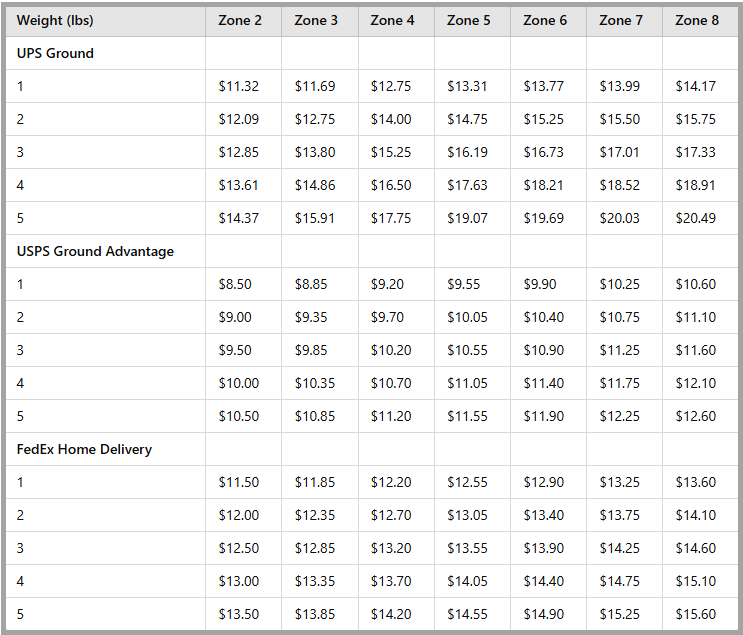
6. Try Amazon Shipping
Amazon Shipping is the newest last-mile shipping service meant to complement and partially replace existing national providers like UPS, USPS, and FedEx. It started by servicing only Fulfilled by Amazon (FBA) orders but has since been aggressively recruiting high-performing retailers to use Amazon Shipping at low teaser rates. If you are a top-rated Seller on Amazon and haven’t received any such invitation, you should reach out to your Amazon contact and try to make your case for it as it offers reliable delivery in two to five days to the majority of the contiguous United States. Pickup and delivery is available seven days a week with no additional weekend delivery fees or residential surcharges.
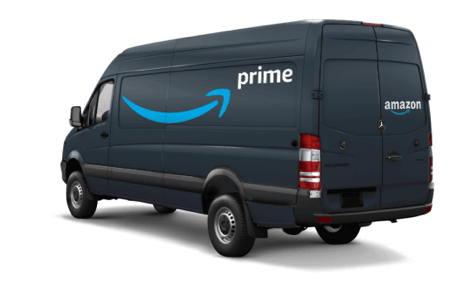
Amazon Shipping uses Delivery Service Partners (DSPs), that is, freelance partners delivering on behalf of Amazon, while Amazon provides the technology needed for drivers to successfully pick up and deliver packages. By awarding delivery routes to DSPs, the management of the fleet and employees is borne by the outsourced companies, the dependence on traditional shipping carriers is eliminated, and Amazon can offer fast deliveries at lower costs than the unionized national carriers.
Amazon Shipping can sometimes be cheaper than the discounted shipping rates that Amazon offers to merchants using its FBA program. With total control over operations and a contracted workforce, Amazon can run an efficient and lean operation and pass on incredible savings to its participating merchants.
7. Take Advantage of ‘Hybrid’ Shipping Services
Hybrid services are a great example of how competitors work together to increase value by working in their areas of expertise. The most expensive component of shipping is the last-mile delivery. And the ground distribution network, especially in residential areas, has never been strong for large national carriers such as UPS and FedEx. So they work together with USPS to offer ‘hybrid’ services; the moniker originates from this collaboration, (aka ‘co-opetition’, that is, cooperative competition), which makes it possible to leverage what each does best to maximize efficiency and lower costs.
Carriers supporting consolidation services collect large volumes of packages, sort them in their own ground network facilities, consolidate them, and then inject them into the USPS network way downstream for delivery to the doorstep (that USPS is already touching every day), effectively outsourcing the final delivery.
Consolidation services are using the USPS Parcel Select service that has a delivery timeline between two and seven days, however, these shipments are lower priority and can sometimes take up to 10 days to deliver. So while much less expensive than UPS, FedEx, and USPS Ground services, packages can take 2 to 5 days longer to deliver to your customer. If your business offers recurring subscription purchases like dog food, you may not care how long transit takes, you just need to ship a few days earlier to meet your customer’s subscription expectations.
Hybrid shipping services are ideal for packages weighing less than 10 pounds (the lighter, the better), and best for residential, non-urgent, low-value domestic deliveries. Outside of this sweet spot, the prices for hybrid services may be comparable to other service types but hybrid services will take longer to deliver.
Packages heavier than 10 pounds should use standard ground shipping or Priority Mail Flat Rate box (because if it fits, it ships; up to 70 pounds, regardless of distance). And the Priority Mail delivery expectation is 1 – 3 days, making it a good option for shipments that need to arrive quickly but don’t require expensive overnight services.
See the 2025 FedEx Ground Economy delivery details and package weight and size limits:
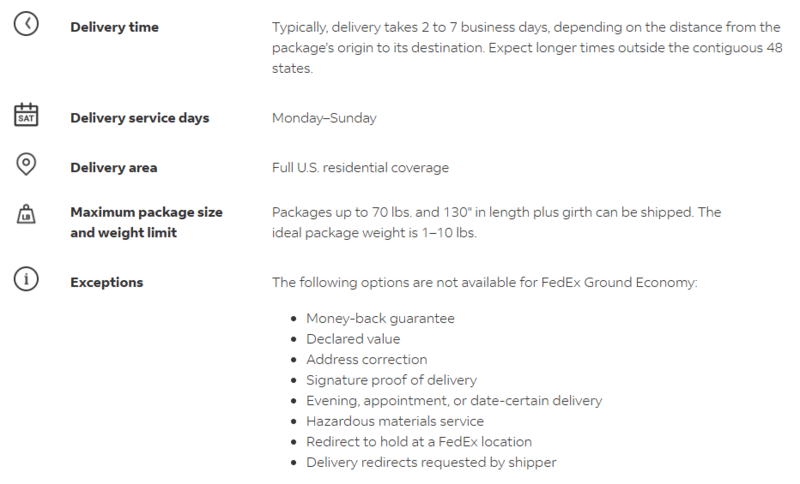
image courtesy: FedEx
Here’s a UPS Mail Innovations graphic depicting how consolidation services ‘skip’ steps along the USPS sortation and delivery journey and get injected into the USPS network much further downstream, often one step before residential delivery:
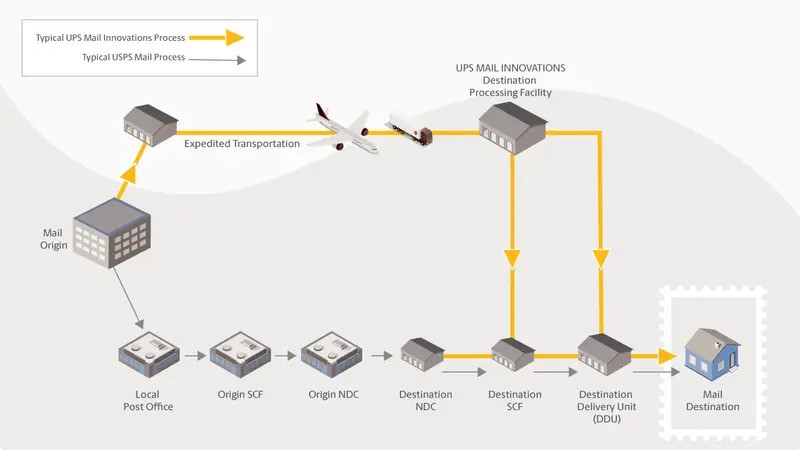
image courtesy: UPS
Note: there are substantial minimum volume commitments to qualify for free pickup of packages by many of the consolidation services. Some piggyback on existing infrastructure, while others require separate workflows and must be kept separate from standard ground shipping services. Make sure to understand how your workflows will change when implementing these services.
8. Consider a Regional Carrier or Regional Rates
Some carriers operate in specific regions only; they are often less expensive compared to FedEx or UPS because they operate in a smaller area and use mainly ground transportation for delivery. By avoiding expensive air cargo, ground services don’t have to help absorb some of the overall operational costs. Their delivery networks are typically limited, but many of them cover a wide range of states with fast deliveries. Some of the prime examples of such carriers are:
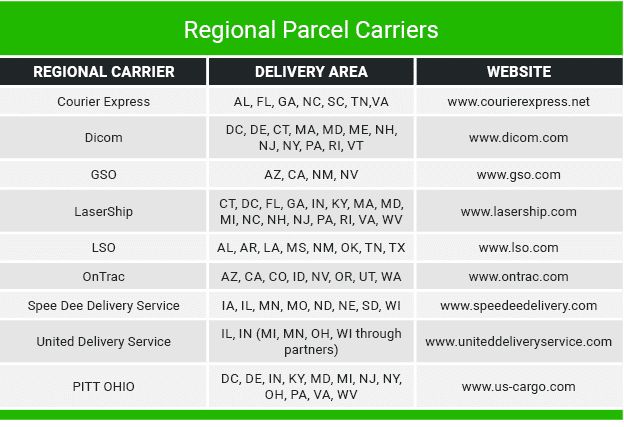
Note: LaserShip and OnTrac merged and now operate under the name OnTrac.
Regional carriers typically provide better services than national carriers because they specialize and operate in a smaller area. They can provide same day or next day delivery options for deliveries that usually take a couple of days through FedEx and UPS.
They are more flexible in accommodating the requests of online Sellers too. Since they have a smaller base of customers and fewer packages to handle, it is not uncommon for them to provide later pickup time and earlier deliveries.
9. Avoiding Residential Address Surcharges
UPS and FedEx, the biggest national carriers, add a surcharge for all shipments to residential addresses. A carriers’ definition of a residential addresses isn’t always clear, but you can reduce some of your costs by planning around residential surcharges and encouraging customers to ship to their office building or a commercial pickup location (e.g. The UPS Store, FedEx Office, or a Pickup Locker). Benefits to the customer include:
- Accurate Delivery: Carriers don’t leave packages at the wrong address by accident, creating a WISMO (Where is My Order) customer service event.
- Improved Successful Delivery Rate: Helps people living in densely populated, urban areas such as apartment buildings.
- Security and Safety: Office buildings often have secure access and reception areas, reducing the risk of packages being lost or stolen compared to home delivery.
- Convenience: Packages can be received during business hours without needing to adjust a personal schedule or worry about missed deliveries.
- Immediate Access: Packages can be opened and inspected immediately upon arrival, which is helpful for checking for damage or errors.
- Reduced Delivery Attempts: Since someone is usually available during business hours, there are fewer chances of multiple delivery attempts, which can delay receipt and require pickup from inconvenient carrier locations.
- Less Disturbance at Home: This can be beneficial if they work from home or prefer not to have deliveries to a residence (for example, dogs may start barking and disturb a work phone call in progress).
UPS defines residential delivery as delivery to a location that is a home, including a business operating out of a home.
FedEx adopts a similar definition of a residential address:
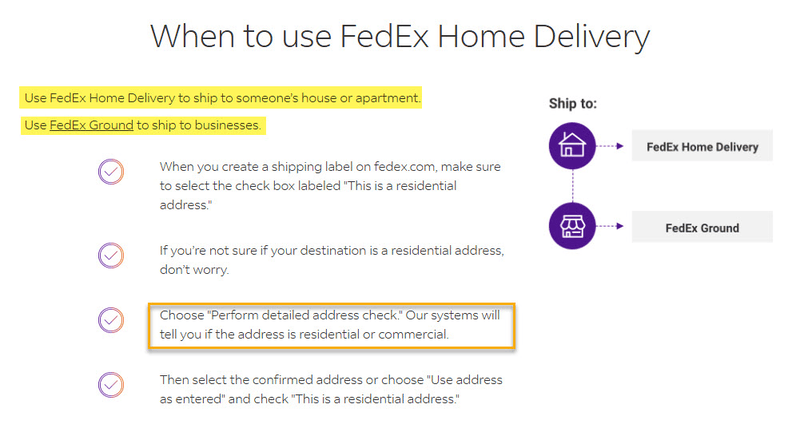
image courtesy: FedEx
You can find the complete list of surcharges for FedEx and UPS on their site here.
Carriers impose residential surcharges because, to them, it is more expensive to deliver to a residence. A courier can deliver many packages to many different businesses in a single trip to a commercial building, whereas typically a courier makes one delivery to a single residential address at a time.
It’s important to choose the right shipping service to avoid surcharges. For example, FedEx Ground is cheaper than FedEx Home Delivery, but when shipped to residential addresses, the shipper will incur a ~$4 fee that will be reflected on the invoice. Be careful not to make too many mistakes or your carrier account and negotiated rates may be negatively impacted.
Another way to avoid residential surcharges is to utilize hybrid services such as UPS SurePost and FedEx Ground Economy, (or even Amazon Shipping), all of which do not impose this fee. Also, keep in mind that hybrid services do not give you a guaranteed delivery day and take longer to deliver by design.
Also, analyzing your past shipments will help you understand just how much of a problem residential surcharges are for you so you can take action accordingly. The surcharges may not seem like much, but when shipping high-volume and utilizing a less ideal carrier/services mix, they can add up quickly.
The solution is to separate your deliveries for home and commercial addresses and select delivery methods accordingly. While we can’t force the customers to only ship to a commercial address, you can make it easier to create the correct shipping labels (and make fewer mistakes) by asking the customer to identify in the address type if it is a commercial or residential address. Lastly, there are intelligent shipping software solutions like Cahoot that provide accurate address type identification using USPS and UPS databases, along with auto-rate shopping across all carriers and services to help you ship as economically as possible.
10. Use Zone Skipping for High Volume Zones
Zone skipping is a practice of consolidating orders and shipping them together to a destination region. From there on, the parcels can be shipped individually within the destination region. The shipping cost is often calculated by the number of regions or ‘zones’ a package travels through to reach the destination. Through zone skipping, the parcel is injected into the carrier’s network directly into the destination zone. Hence, the term Zone-Skipping.
This is ideal for online Sellers with a large volume of sales within a region. If you have close to a truckload of orders from a zone every day, zone skipping is for you. Your objective should be to get your orders as close to the destination as possible in fewer stops and sorts, where the shipping carrier can pick up and deliver each package to the final destination.
For example, if you are based out of Detroit (Zone 1) and have a considerable volume of orders from Southern California (Zone 8); if you ship all your orders directly, you will pay high shipping rates for Zone 8 for all orders. With zone skipping, you can bundle all your orders going to Southern California every couple of days and send them by truck in bulk. Once in Southern California, packages are picked up by the shipping carrier and shipped within the Zone at lower rates. You save big because paying for bulk transportation is far cheaper than the difference between zone 8 and zone 1 shipping rates per unit.
Here is a snapshot of how zone skipping saved money for two online merchants:
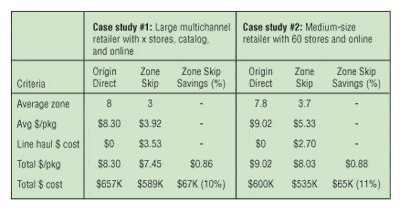
image courtesy: MultiChannelMerchant.com
USPS Parcel Select is a great complementary service to zone skipping. Under Parcel Select, Sellers drop their packages in bulk at a postal facility as close to the destination as possible. Not only, do they save on zone-skipping, but Parcel Select also offers an additional discount for bulk shipping, similar to the hybrid shipping services mentioned above. But in this case, you’re dealing directly with USPS without the intermediaries.
11. Use International Freight Forwarders to Fulfill International Orders
Shipping international from the US can be a costly affair. Besides, international shipping can be an operational headache too. There are several things to consider. You need enough manpower and time to manage the different aspects of international shipping that aren’t considerations for domestic shipments.
International Freight Forwarding services carry out the logistics operations on behalf of a firm. These generally involve, as the name suggests, large orders. But these days, a lot of freight forwarding agencies offer services tailored to ecommerce Sellers, for example, less-than-container load (LCL) services, where they bundle your parcels with other parcels to fill pallets and containers, which are then delivered to your destination country via the conventional freight network. At the destination, the last-mile delivery is done by the local postal service in the destination country.
This end-to-end process is taken care of by the freight forwarder. Online Sellers enjoy savings since they get a bulk freight discount for what is essentially parcel shipping, and only have to deal with their freight forwarder. Freight Forwarders also provide support for calculating real-time duties, taxes, and other governmental fees to present itemized final prices to customers as well as costs to Sellers before the sale is made.
In some cases, if you have an order fulfillment provider like Amazon FBA in the destination country, a freight forwarder ensures that your items reach the fulfillment provider’s warehouses.
A good example of such a service is DHL eCommerce (formerly Global Mail) which provides a solution tailored for online Sellers.
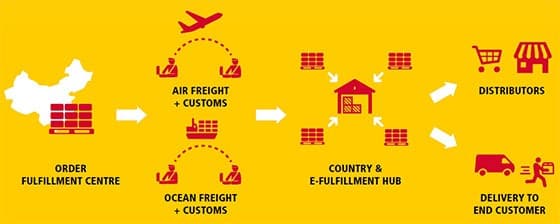
12. Selling Internationally through Full-Service Cross-Border Solutions
While domestic sales and fulfillment can be taken care of using the shipping strategies we’ve discussed so far, selling and delivering to customers in other countries is a whole other ball game.
Aside from accurately calculating shipping charges and various import fees, there are a few other things that an online Seller needs to do. To avoid surprises, your customer must understand your product’s pricing and the different tariffs included in the final landed cost. Additionally, having familiar payment options at checkout would reduce hesitancy, for example, by allowing payment via China Union Pay, WeChat, or Alipay.
Thankfully there are cross-border solutions such as Global-e’s BorderFree and International Localized Checkout that provide a comprehensive solution for selling to international customers. An end-to-end solution typically includes:
- Localization of your product content and checkout pages in locale-specific language, UI, and currency.
- Calculation of duties, taxes, and import fees for transparent final pricing to customers before the order is placed.
- Presenting and processing country-specific payment options.
- Efficient international order fulfillment using freight forwarders and other service providers.
The following checkout page is an example of an online store that uses Global-e to display the page to a Chinese customer buying from a Seller located in Australia:
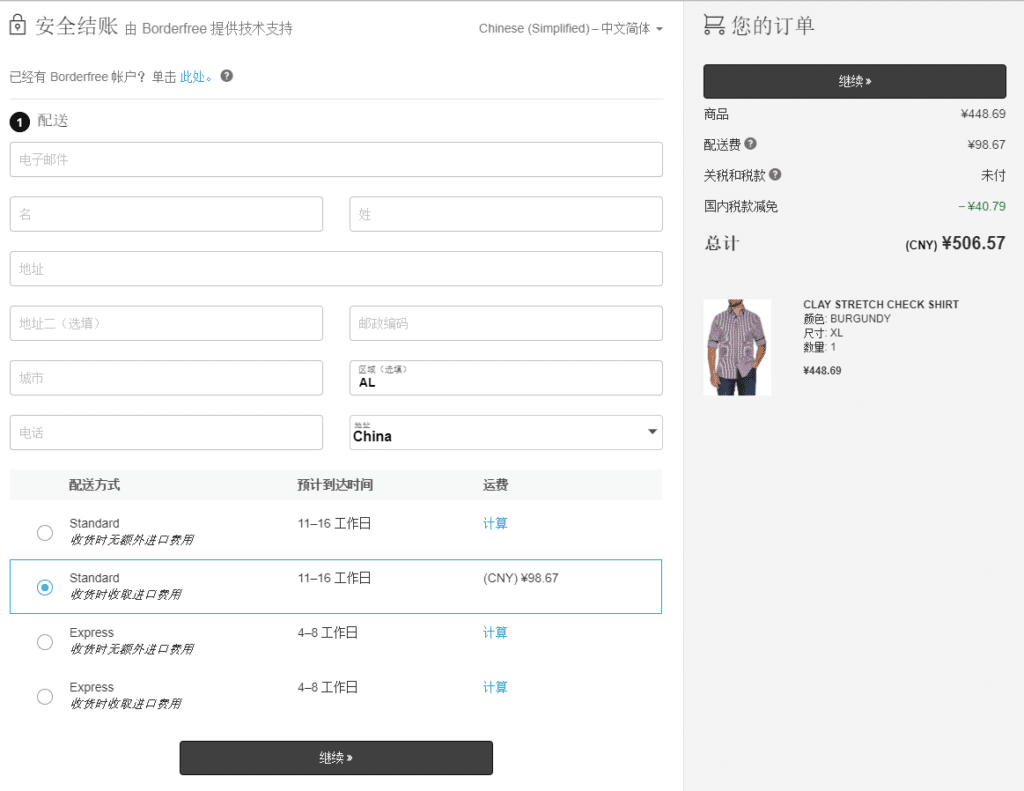
Summary
Mastering shipping isn’t just about saving a few dollars per package — it’s about building a sustainable and profitable business that encourages customer loyalty while building a scalable foundation for future growth. The strategies outlined here, from negotiating better carrier rates to leveraging hybrid shipping solutions, are designed to help you take control of your logistics instead of letting them control you. In an era where customer expectations are sky-high and operational costs are constantly climbing, businesses that optimize their shipping program can carve out an undeniable edge over competitors. Whether you’re a growing e-commerce brand or an established retailer, the right approach to shipping will not only protect your margins but also ensure a seamless experience for your customers. The key is to stay adaptable, explore new opportunities, and continually refine your strategy — because in shipping, as in business, the smartest players always come out ahead.
Download The Ultimate Guide to Profitable Free Shipping
Frequently Asked Questions
What is the most cost-effective shipping method?
Generally speaking, for standard delivery service, (1 – 5 days), USPS is the cheapest option for smaller, lighter packages that are traveling short distances, while UPS and FedEx tend to be cheaper for larger packages traveling longer distances. However hybrid shipping services where consolidator carriers accumulate and inject mass quantities of packages into the USPS network for final mile delivery take much longer to deliver, but can offer substantial savings over standard delivery services.
Does offering free shipping increase sales?
Yes, offering free shipping can increase sales. Studies show that free shipping is a key factor in purchasing decisions.
What is free shipping?
Free shipping is a marketing strategy used by online stores that allow shoppers and customers not to have to pay an additional fee when placing orders for particular items. From the online shopper’s perspective, getting no additional cost added to an item purchased makes shopping much easier.
Who really pays for free shipping?
There Is No Such Thing as “Free Shipping”. It is a fact that shipping costs are being paid for, whether consumers know it or not. Customers ultimately pay for this perk, even if it is not specified in their online shopping cart. The cost is lumped in with the final price of the goods they buy.
What is a good free shipping threshold?
Knowing how much an average customer spends per transaction can provide a better idea of what a business’ minimum order value for free shipping should be. A free shipping threshold should be about 30% above the average order value.
What is the psychology of free shipping?
The psychology of free shipping shows that customers often perceive free shipping as a better deal than a discount. This perception increases the perceived value of a purchase and encourages higher spending.
How do businesses make money with free shipping?
Free shipping can help boost sales. Shoppers believe they’re getting a better deal when they don’t have to pay for shipping costs which can help increase cart sizes. Customers will buy more to get free shipping and will take their business elsewhere if they can’t.

Up to 64% Lower Returns Processing Cost
